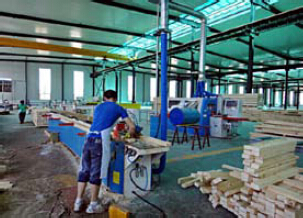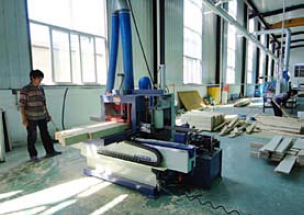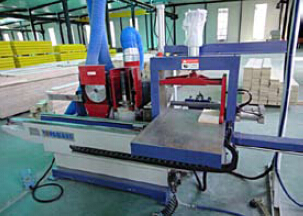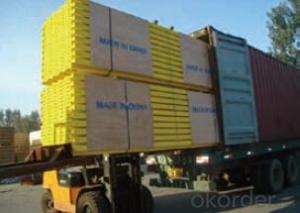Timber Beam H-20 for formwork and scaffolding systems
- Loading Port:
- Tianjin
- Payment Terms:
- TT OR LC
- Min Order Qty:
- 50 m²
- Supply Capability:
- 1000 m²/month
OKorder Service Pledge
Quality Product, Order Online Tracking, Timely Delivery
OKorder Financial Service
Credit Rating, Credit Services, Credit Purchasing
You Might Also Like
Characteristics:
◆ Standardized production lines.
Supply capability: 3000m/day, Lmax = 6600mm.
◆ Finger jointing of the flange and web, the strength of timber beam is highly improved.
Max. shearing force failure load:40KN
◆ Well treated to prevent from water penetration or erosion, so the service life maximally extended.
Normally, CNBM timber beam H20 can be used for 4 to 5 years, the exact using time would depend on maintenance & storage.
◆ Robust caps at the end of the girders protect against damages.




- Q:What are the different safety certifications and standards for steel formwork?
- Steel formwork is subject to various safety certifications and standards to guarantee its safe use in construction projects. These certifications and standards ensure that the steel formwork meets specific safety requirements. Some of the safety certifications and standards for steel formwork include the following: 1. ISO 9001: This certification confirms that the steel formwork manufacturer has implemented a quality management system and meets the necessary quality standards. It focuses on the overall quality and reliability of the product. 2. ISO 3834: This certification guarantees that the welding processes used in the production of steel formwork adhere to specific quality requirements. It emphasizes the welding quality and ensures strong and durable welds. 3. EN 12812: This European standard provides guidelines for the design and performance of formwork systems, including steel formwork. It covers aspects such as load-bearing capacity, stability, and safety requirements for formwork systems. 4. OSHA: The Occupational Safety and Health Administration establishes safety standards for the construction industry in the United States. While there are no specific certifications for steel formwork, compliance with OSHA standards is crucial to ensure a safe working environment for construction workers who use steel formwork. 5. BS 5975: This British standard offers recommendations for temporary works, including formwork systems. It covers design, erection, use, and dismantling of formwork systems, ensuring safety throughout the construction process. 6. ACI 347: This American Concrete Institute standard provides guidelines for the design, construction, and maintenance of concrete structures. It includes recommendations for formwork systems, including steel formwork, to ensure their safety and effectiveness in supporting the concrete during construction. These safety certifications and standards are essential to manufacture and use steel formwork safely in construction projects. By adhering to these certifications and standards, construction companies can guarantee the safety of their workers and the quality of their structures. It is crucial for construction professionals to be aware of these certifications and standards and ensure compliance with them when utilizing steel formwork.
- Q:What are the common durability issues with steel formwork systems?
- There are several common durability issues that can arise with steel formwork systems. One of the main concerns is corrosion, which occurs when the steel comes into contact with moisture or aggressive chemicals. Corrosion can weaken the structural integrity of the formwork system and lead to premature failure if not properly addressed. Another durability issue is wear and tear. Steel formwork systems are often subjected to repeated use, which can result in surface damage and deformation over time. This can lead to difficulties in achieving accurate and precise concrete finishes, as well as pose safety risks for workers. Additionally, improper handling and storage of steel formwork systems can result in bending or warping of the components. This can affect the overall stability and effectiveness of the system, making it less durable and reliable. Finally, inadequate maintenance and lack of proper protective coatings can contribute to durability issues. Regular inspections, cleaning, and applying protective coatings can help prevent corrosion and extend the lifespan of the steel formwork system. In conclusion, common durability issues with steel formwork systems include corrosion, wear and tear, improper handling and storage, and inadequate maintenance. It is crucial to address these issues promptly and implement proper maintenance practices to ensure the longevity and effectiveness of the formwork system.
- Q:Can steel formwork be used for both regular and irregular concrete shapes?
- Yes, steel formwork can be used for both regular and irregular concrete shapes. Its versatility and strength make it suitable for creating various shapes and sizes, whether they are standard or unconventional.
- Q:How does steel formwork affect the overall aesthetics of a structure?
- Steel formwork does not have a direct impact on the overall aesthetics of a structure as it is a temporary structure used for shaping and supporting concrete during construction. However, steel formwork can indirectly affect aesthetics by allowing for precise and smooth finishes, resulting in a more visually appealing final product. Additionally, steel formwork's strength and durability ensure structural integrity, which is essential for maintaining the long-term aesthetics of the structure.
- Q:What are the different types of formwork clamps used in steel formwork?
- There are several types of formwork clamps used in steel formwork, including wedge clamps, hook clamps, butterfly clamps, and panel clamps.
- Q:How does steel formwork contribute to the strength and stability of a concrete structure?
- Steel formwork is a critical component in the construction of concrete structures as it plays a crucial role in enhancing their strength and stability. One of the key ways in which steel formwork contributes to this is by providing a robust framework for the concrete to be poured into and cured. The steel formwork acts as a mold or a template that holds the liquid concrete in place until it solidifies. This ensures that the concrete takes the desired shape and form, resulting in a structurally sound and stable structure. Furthermore, steel formwork provides support and reinforcement to the concrete during the curing process. As the concrete hardens, it exerts pressure on the formwork. The high tensile strength of steel allows it to withstand and distribute these forces evenly, thereby preventing any distortion or collapse of the structure. This is particularly important in the case of large-scale or complex structures where the concrete needs to be supported over extended periods. In addition, steel formwork facilitates the proper alignment and leveling of the concrete during the construction process. The rigid nature of steel ensures that the formwork remains in place and maintains its shape, resulting in accurate dimensions and a uniform finish. This contributes to the overall strength and stability of the concrete structure by eliminating any irregularities or weaknesses that may arise from inaccuracies in the formwork. Moreover, steel formwork can be easily assembled and disassembled, allowing for efficient construction processes. This flexibility enables faster construction timelines, minimizing the exposure of the concrete to external elements and reducing the risk of structural damage. The ability to reuse steel formwork also makes it a cost-effective solution for multiple construction projects. Overall, the use of steel formwork significantly enhances the strength and stability of concrete structures by providing a sturdy framework, supporting the curing process, ensuring accurate alignment, and facilitating efficient construction practices. Its durability, strength, and versatility make it an essential component in the construction industry, contributing to the creation of safe and reliable concrete structures.
- Q:Can steel formwork be used for both flat and sloped concrete surfaces?
- Yes, steel formwork can be used for both flat and sloped concrete surfaces. Steel formwork is known for its versatility and durability, making it suitable for various types of concrete structures. It can be easily adjusted and shaped to create both flat and sloped surfaces, allowing for the construction of diverse architectural designs. Additionally, steel formwork provides excellent support and stability to the concrete during the pouring and curing process, ensuring a high-quality and uniform finish on both flat and sloped surfaces.
- Q:Does steel formwork require any special expertise or training for installation?
- Installation of steel formwork necessitates specialized expertise and training. Steel formwork comprises intricate interlocking panels and components that serve as temporary molds for pouring concrete structures. It demands a comprehensive grasp of formwork design, installation techniques, and safety protocols. Professionals who engage in steel formwork must possess in-depth knowledge of project-specific prerequisites, including load-bearing capacity, formwork connections, and appropriate reinforcement placement. They must also be capable of accurately measuring and cutting steel panels, assembling them correctly, and ensuring proper alignment and bracing of the formwork. Additionally, proficiency in steel formwork installation entails familiarity with various formwork systems, such as adjustable steel formwork, modular steel formwork, or tunnel formwork. Selecting the most suitable system for a given project is paramount. This knowledge is critical to guarantee that the formwork can endure the pressure exerted by wet concrete and yield a structurally sound and visually appealing end result. Furthermore, comprehensive training in steel formwork installation is indispensable to ensure the safety of workers and the overall success of the construction endeavor. This encompasses understanding safety regulations, employing personal protective equipment effectively, and being mindful of potential hazards and their mitigation methods. In conclusion, given the intricate nature and specific requisites of steel formwork installation, it is imperative to enlist professionals possessing the requisite expertise and training to facilitate a streamlined and prosperous construction process.
- Q:How does steel formwork affect the overall durability of a structure?
- The durability of a structure can be greatly influenced by steel formwork. Steel formwork is known for its strength and durability, which provides excellent support and stability during the construction process. This ensures accurate construction according to required specifications, which is vital for long-term durability. Using steel formwork offers several advantages. It has the ability to withstand high pressures and loads, which is especially important in large-scale construction projects involving heavy concrete pours. The steel formwork effectively distributes the weight and pressure exerted by the concrete, preventing any deformation or collapse. This helps maintain the structure's integrity and durability over time. In addition, steel formwork is highly resistant to environmental factors such as moisture, humidity, and temperature changes. This resistance protects the structure from potential damage such as corrosion, rot, or warping, enhancing its overall durability. This reduces the need for expensive repairs or maintenance. Furthermore, steel formwork provides a smooth and even surface for the concrete to adhere to during the curing process. This results in a uniform and consistent finish, reducing the risk of cracks or weak points in the structure. This absence of defects improves the structure's durability, as it is less prone to structural weaknesses that can compromise its integrity over time. Moreover, steel formwork is reusable and can be easily dismantled and reassembled for multiple construction projects. This not only reduces construction costs but also minimizes waste and environmental impact. The ability to reuse steel formwork ensures consistent use of high-quality materials, contributing to the structure's long-term durability. In conclusion, steel formwork plays a significant role in determining the overall durability of a structure. Its strength, resistance to environmental factors, ability to distribute loads, and provision of a uniform finish all contribute to the long-term durability and structural integrity of the building. By utilizing steel formwork, builders can ensure that the structure is built to last, minimizing the need for future repairs or replacements.
- Q:How does steel formwork affect the overall construction waste generation?
- Steel formwork can significantly reduce the overall construction waste generation in several ways. Firstly, steel formwork is reusable, which means it can be used multiple times for different projects. Unlike traditional timber formwork, which often needs to be disposed of after a single use, steel formwork can be dismantled, transported, and reassembled for use in future construction projects. This reduces the amount of waste generated from formwork materials. Additionally, steel formwork is more durable and resistant to damage compared to other types of formwork. It can withstand greater pressure and is less likely to deform or break during the construction process. This durability reduces the need for frequent replacements and repairs, further minimizing waste generation. Moreover, steel formwork allows for precise and accurate construction, resulting in less material wastage. Its rigid structure ensures that concrete is poured and cured in the desired shape and dimensions, reducing the need for excessive concrete pouring or trimming. This eliminates unnecessary material usage and reduces the amount of construction waste generated. Furthermore, steel formwork is easier to clean and maintain compared to other formwork materials. It can be cleaned and repaired more efficiently, reducing the chances of material degradation and the need for replacement. This not only extends the lifespan of the formwork but also reduces the waste generated from discarded or damaged formwork materials. Overall, the use of steel formwork in construction projects has a positive impact on waste generation. Its reusability, durability, accuracy, and ease of maintenance contribute to minimizing the amount of construction waste generated, making it a more sustainable option for formwork in the construction industry.
1. Manufacturer Overview |
|
|---|---|
| Location | |
| Year Established | |
| Annual Output Value | |
| Main Markets | |
| Company Certifications | |
2. Manufacturer Certificates |
|
|---|---|
| a) Certification Name | |
| Range | |
| Reference | |
| Validity Period | |
3. Manufacturer Capability |
|
|---|---|
| a)Trade Capacity | |
| Nearest Port | |
| Export Percentage | |
| No.of Employees in Trade Department | |
| Language Spoken: | |
| b)Factory Information | |
| Factory Size: | |
| No. of Production Lines | |
| Contract Manufacturing | |
| Product Price Range | |
Send your message to us
Timber Beam H-20 for formwork and scaffolding systems
- Loading Port:
- Tianjin
- Payment Terms:
- TT OR LC
- Min Order Qty:
- 50 m²
- Supply Capability:
- 1000 m²/month
OKorder Service Pledge
Quality Product, Order Online Tracking, Timely Delivery
OKorder Financial Service
Credit Rating, Credit Services, Credit Purchasing
Similar products
New products
Hot products
Hot Searches
Related keywords























